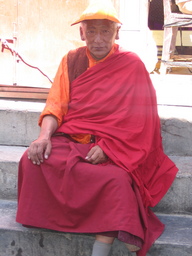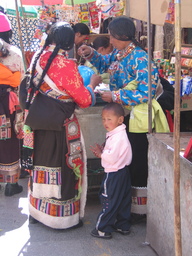
2005.10.06 Lhasa, Tibet

I think this will be my last night in Lhasa. As ambivalent as I was about the city upon arrival, I an now equally reluctant to leave.
I can't see how I wasn't instantly captivated by the Tibetan Quarter, especially the area around the Jokhang Temple. That is the holiest of sites in Tibetan Buddhism; pilgrims from all across Tibet journey there. Walking a clockwise circuit around holy sites brings merit. The road around the Jokhang is known as the Barkhor.
Pilgrims come from all regions of Tibet, their appearances differ greatly. Men across Tibet grow their hair long, then braid it with red string. Those from the west often have a large chunk of turquoise jade in a pierced ear. Women from eastern Tibet have the most amazing braids... similar to West African cornrows, but woven even finer. At first it was all overwhelming, seeing so many people in colorful costume. Now I've begun to distinguish the differences in where people are from, noting the variety of stones used in hair clips, size of buckle across the sash, or the pattern of embroidered trim along the hem of their robe.
It's not just the unique garb of the pilgrims walking the circuit around the temple. There's a combination of sensory input that makes the area so enchanting. The scent of incense mingled with yak-butter candles is intoxicating. It's unbelievable to see the devotion of the people: old women repeatedly prostrate themselves, bringing their entire body flat out to the ground over and over. Hand-held prayer-wheels seem to be an obligation while walking any distance.
The interior of the Jokhang itself has amazing atmosphere: friendly monks, long halls of large prayer wheels, and elaborate chapels to important figures. The art is amazing. I wish I understood more of the background of Buddhism, so could appreciate the significance of what I'm seeing. Why does this figure have three eyes? How about this statue, with five heads and a brilliant, conical, cap? I'll have to do some research.
Yesterday I was happy to find that a vendor along the Barkhor was selling pens for Tibetan calligraphy. They were unique: rather than a left- or right-cut nib, as would be found in Islamic or Western calligrahpy, the nib was perfectly even. The woman asked a reasonable 3 yuan per pen, 1 yuan for a jar of ink. Prices for the other items sold along the circuit tend to be inflated outrageously, especially for foreign visitors. I bought three pens and a jar of ink, not even attempting to bargain.
 Tibetan Women Buy a Ball |
If this indeed turns out to have been my final evening in Lhasa, it was well spent: two dinners, copious drinks, and lots of socialization. Despite that Lu Jun and Wang Lei had stopped off at different cities on the way to Lhasa, we've all managed to meet up while here. Lu Jun has a friend who lives here, an older Chinese man. This local knows the city well and took us to the best Tibetan restaurant I've been. In addition two other friends of Lu Jun who happened to be traveling around Tibet joined us, so we were six.
Quite honestly most of the other Tibetan food I've tried was mediocre. There didn't seem to be much variety, most dishes tasted bland. The Snowlands restaurant on West Beijing Road has changed my impression of that. Lots of yak. Blood sausage. Real, heavy bread--not the fluffy, sweet Chinese stuff, or the stale nan found in Xinjiang. Tasty potatoes. True to Chinese dining etiquette, there was well too much food: over a dozen dishes. Also true to Chinese dining etiquette, there was non-stop toasting each other and drinking. Fortunately the beverage of choice was weak Lhasa Beer, so I was able to participate--I have a low tolerance for alcohol.
After Tibetan dinner, we joined other Chinese travelers at a Szechwan hotpot restaurant. Again there was alcohol, this time Tibetan chang. I couldn't drink or eat much more, but stayed on as long as I felt was polite. It was good to have companions; I felt positive that I was in a sustained non-English speaking situation.
 First Dinner |
There were eight others for second dinner, all in their mid-twenties to thirties. Without exception they hailed from the elite Chinese cities: Beijing, Shanghai, Guangzhou, and Xiamen. I've really been stricken by how alive the Chinese backpacker scene is. Of course my dinner companions weren't quite a parallel to the middle-class American student who decides to pick up a Eurail Pass for the summer. Anybody who can afford travel like this in China is probably fairly wealthy. I didn't ask who was picking up the tab at either location, nor should I have.
I plan to take the bus to Dunhuang tomorrow. Nisagul sent me e-mail letting me know that it's not worth it to buy the ticket all the way to Dunhuang. Despite that her bus was destined for Dunhuang, there were so few passengers making the full journey that the bus driver just let everybody off at Golmud, several hours shy of Dunhuang. The fare diffrence is 90 yuan. On top of that, she suggested just showing up as the bus is leaving. If the bus isn't full, dealing directly with the driver should be good for an additional 50 yuan discount.
Of course that runs the risk that I won't catch the bus at all, if it's full. But that wouldn't be so bad. Another night in Lhasa would be fine with me.